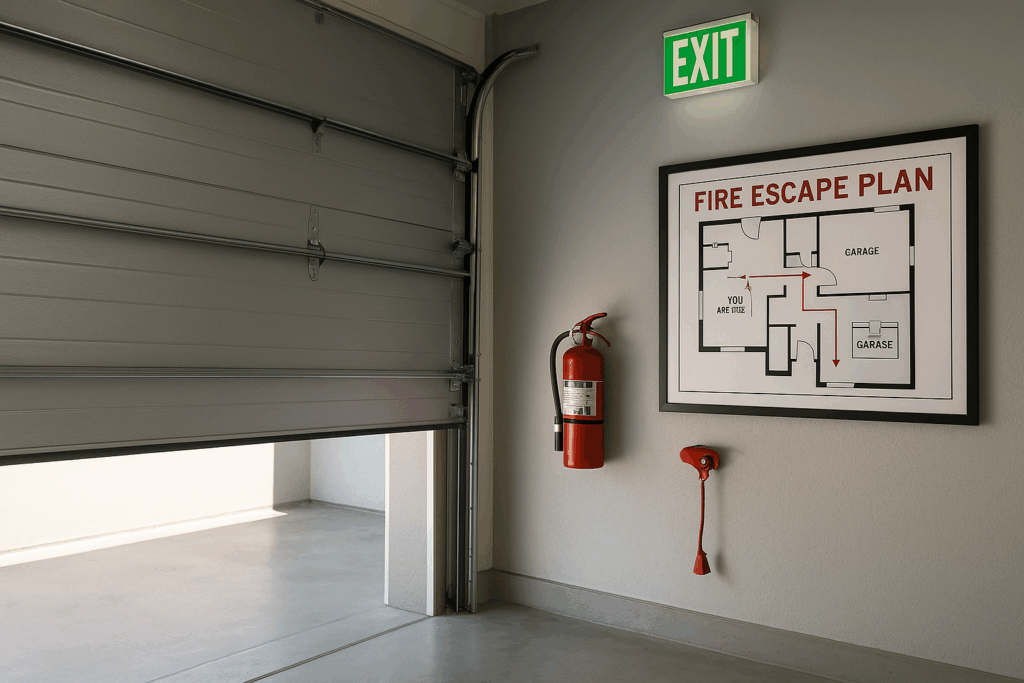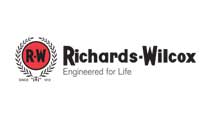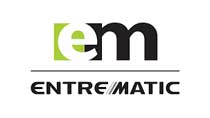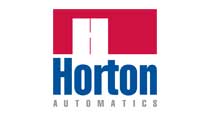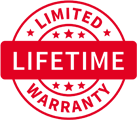Key Takeaways
1. The garage is one of the most fire-prone spaces in any home, and a fire-rated garage door with proper seals and manual override ensures that heat and smoke stay contained.
2. A fire escape plan works best when everyone knows their exits, knows their maps, practices twice a year, and keeps pathways clear.
3. Anchor Doors & Service Inc installs, tests, and maintains Rolling Steel Fire Doors and UL/ULC-rated counter shutters that meet NFPA 80 standards.
Why Your Garage Door Matters in Fire Escape Planning
Fire escape planning is often the most overlooked yet most combustible space in a home. Fires that start in garages spread quickly due to:
- Stored flammable liquids, paints, and solvents
- Vehicles with fuel or battery systems ready to ignite
- Heating equipment or power tools used near combustible materials
In Canada, home fire incident data for 2020-21 show that nearly 39,000 fires were reported in residential dwellings. While the data do not isolate garage fires specifically, global research shows that modern parking-garage fires escalate faster due to vehicle battery or plastic loads.
Because the garage often connects directly to living areas, heat and smoke can travel into the home in minutes. That’s why including your garage in your plan is necessary. A properly installed fire-rated garage door, paired with a manual override and backup power, gives occupants precious extra time to evacuate safely.
How to Prepare a Fire Escape Plan (and Where the Garage Fits In)
A fire escape plan is your family’s roadmap to safety, and it starts with awareness. If you lack in preparation, it may turn small, containable fires into fatal events.
Here’s how you can be prepared:
1. Map Every Exit
Draw a floor plan of your home and mark every possible way out. The garage door is often overlooked, but in many homes it’s one of the quickest paths outdoors.
Ensure the interior access door from the house to the garage is fire-rated and self-closing, and that the garage door itself can be operated manually during power failures.
Practice disengaging your garage’s manual release cord so everyone knows how to open it if the motor fails during a fire.
2. Establish Two Ways Out from Every Room
If smoke or flames block one path, there must be another. This can mean a window with an escape ladder, or an adjacent room that leads to the garage exit.
For example, in 2024, a Toronto family escaped through their garage after a kitchen fire blocked their front door. The garage’s side door became their lifesaver.
3. Choose a Safe Meeting Point
Pick a visible location like a streetlight, mailbox, or neighbor’s driveway where everyone meets after escaping. Never return inside once out. Practice getting there from all exits, including the garage.
4. Practice at Least Twice a Year
NFPA recommends running two fire drills annually, once during the day and once at night. Include the garage route every time so it becomes second nature. Children, seniors, and pets should all be part of the practice.
5. Keep Escape Routes Clear
Clutter is the enemy of evacuation. Remove storage boxes, tools, or vehicles that block the garage’s side exit or make it harder to lift the door manually. Mark swings arcs on the floor and keeps them free at all times.
6. Test Your Safety Equipment
Check smoke alarms monthly and install one outside the garage entry door. Replace batteries annually. If your garage is attached, ensure there’s a heat detector, not a smoke detector (since vehicle exhaust may cause false alarms).
7. Upgrade to Fire-Rated Doors
Fire-rated doors between your home and garage, such as rolling steel or 45-minute rated steel assemblies, can dramatically slow fire spread.
Anchor Doors & Service Inc. installs and services UL and ULC-rated fire doors, ensuring they close automatically and latch properly, even under extreme heat.
Integrate Your Garage Door Safety Into Your Fire Escape Plan
Integrating the garage into your escape plan will ensure no blind spots and help create a 360° evacuation path. In 2023, a garage fire in Langley, British Columbia, spread through the connecting door into the home before firefighters arrived, displacing two families despite minimal structural damage. Fire officials later confirmed that a non-rated wooden door between the garage and home allowed smoke and heat to pass through.
Garages often adjoin living spaces and may be used as an exit or entry point, so:
- Map a route from the living space through the garage AND directly outside
- Ensure both the garage door and connecting doors are functional so that smoke or blockage in one path doesn’t trap occupants
- Choose a meeting point that is outside the house and outside the garage exit path
Fire Escape Plan Maintenance & Inspection Checklist
| Item | Why It Matters | Check (Yes/No) |
|---|---|---|
| Door closes and seals fully | A properly closing, well-sealed door stops heat and smoke from spreading into escape routes. Test monthly to ensure smooth operation. | ☐ Yes☐ No |
| Manual override tested | During a power outage, you must be able to lift the garage door manually. Practice using the release cord twice a year. | ☐ Yes☐ No |
| Battery backup working | If your garage door opener has a backup battery, check it quarterly so it operates even when electricity fails. | ☐ Yes☐ No |
| Pathway clear of clutter | Keep bikes, storage bins, and tools away from the door swing and exit routes to prevent trip hazards in low visibility. | ☐ Yes☐ No |
| Alarm and sensor test | Test smoke alarms, heat sensors, and door sensors monthly. Replace batteries every year and log the test date. | ☐ Yes☐ No |
How Fire-Rated Rolling Steel Doors Delay Fire and Smoke
Rolling steel fire doors are often used at garage openings and commercial bays. Their steel curtain, intumescent seals, and motor/rollback mechanism create a barrier that remains closed even under fire.
In a fire scenario, the rolling door drops (via fusible link or alarm) and seals the opening. With proper installation, the door preserves the separating wall’s integrity and prevents smoke from entering the home or structure. Canadian and U.S. codes allow these assemblies when listed for the required rating.
Standards: NFPA 80 and Canadian National Building Code
- NFPA 80 governs “fire doors and other opening protectives,” including installation, inspection, testing, and maintenance
- The National Building Code of Canada (NBC) / CAN/ULC S104 requires rated door assemblies for fire separations and defines “fire-resistance rating” in minutes or hours.
Keep Your Fire Escape Plan Ready With Anchor Doors & Service Inc
A fire-rated garage door is a life-saving barrier that gives you time to act, protect your home, and get your family out safely. According to industry experts, garages are among the top three ignition sources for residential fires, which often spread due to delayed detection or unsealed openings. That’s why preparation, proper equipment, and regular maintenance all matter.
Anchor Doors & Service Inc. helps homeowners and businesses strengthen their fire protection in three key ways:
- Inspect Your Garage Exit Route. Walk through your garage and make sure it can serve as a safe emergency exit. Check that the door closes tightly, and the path is clutter-free.
- Upgrade to Fire-Rated Protection. If your current garage door is not fire-rated, consider replacing it. An appropriately rated door slows fire spread, giving you and your family crucial extra time to escape.
- Schedule a Fire Door Inspection. Anchor Doors & Service Inc. helps homeowners and businesses strengthen their fire protection through certified installation, annual drop testing, and customized upgrades using UL and ULC-rated Raynor Fire Doors.
Contact Anchor Doors & Service Inc today for a fire door inspection or maintenance visit. Safety starts with the door that stands between your family and the fire.
FAQs
If equipped and maintained correctly, a garage can serve as a practical emergency exit. Ensure the interior door leading to the garage is fire-rated and self-closing, and that the garage door can be opened manually in case of a power outage.
Strong family fire safety begins with preparation and practice. Every family should have a clear fire escape plan with at least two exits per room, including one through the garage if possible. Run practice drills twice a year, day and night, so everyone knows how to react calmly.


